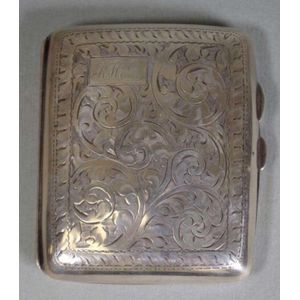Edwardian Sterling Silver Sweetmeat Set with Matching Dishes and Tongs
You must be a subscriber, and be logged in to view price and dealer details.
Subscribe Now to view actual auction price for this item
When you subscribe, you have the option of setting the currency in which to display prices to $Au, $US, $NZ or Stg.
- Edwardian - The Edwardian period of English furniture and decorative arts design is named for Edward VII (1841 ? 1910) who was King of the United Kingdom and the British Dominions and Emperor of India for the brief period from 1901 until his death in 1910. It follows the Victorian period, in turn was followed by the Art Nouveau and Art Deco styles. In Australia, designs of this period are also known as being in the Federation style.
- Sterling Silver - Sterling silver is a mixture of 92.5% pure silver and 7.5% of another metal, usually copper. Fine silver is 99.9% pure silver, and is relatively soft and the addition of the very small amount of copper gives the metal enough strength and hardness to be worked into jewellery, decorative and household objects.
- Hallmarks - A mark stamped on articles of precious metals in Britain, since the 14th century, certifying their purity. It derives its name from the Guild Hall of the Goldsmiths' Company, who recieved its Charter in 1327 giving it the power to assay (test the purity) and mark articles of gold and silver.
The hallmark will consist of several marks, including the:
- silver standard mark, indicating the purity of the metal. Sterling silver is .925 pure silver.
- the city mark indicating the city in which it was assayed eg London, Birmingham, York etc.
- the date mark, usually a letter of the alphabet in a particular font and case,
- a duty mark, indicating whether duty had been paid to the crown, and only in use from 1784 to 1890
The piece may include an additional mark, the maker's mark, although not forming part of the hallmark, will be located in the vicinity of the hallmarks.
Sometimes silver plated items will bear faux hallmarks, often confusing those not familiar with silver markings.
This item has been included into following indexes:
- bowls and dishes, silver - silver, sweetmeat 177
-
dishes
- silver, bon-bon 331
- silver, other 626
Visually similar items

Art Deco silver & diamond brooch, a/f

Sterling silver cigarette case, hallmarked Birmingham 1922 (Lawrence Emanuel), 8.5 cm x 7 cm, 66 grams

Two Russian gold mounted silver cigarette cases, Moscow, 1908-1917, one with a relief scene of a bearded Bogatyr in battle uniform with sword and shield and a town scape in the background, applied gold monogram and signatures, the underside with multiple g

English hallmarked sterling silver purse, with finely detailed floral curlicue design & an engraved cartouche, Chester, 1899, maker Walker & Hall, 10.5 x 8 x 2 cm.
